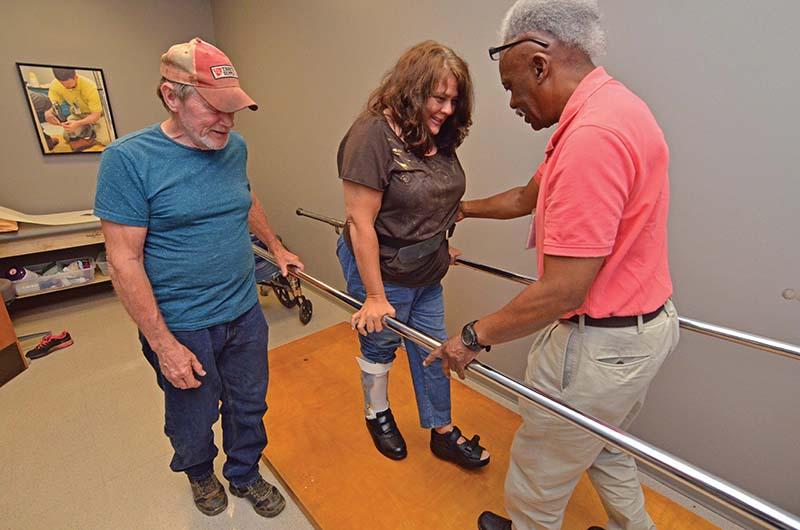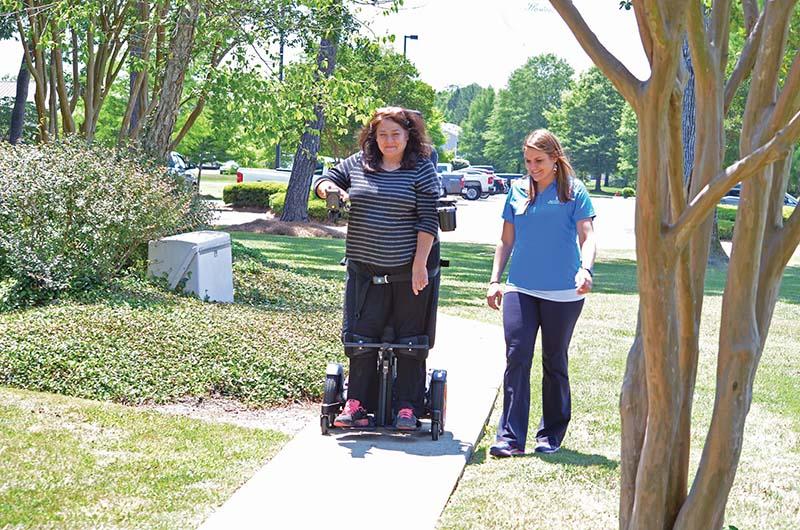Since her spinal cord injury over 20 years ago, Sandra Austin has never stopped believing she could get better. Initially, her doctors didn’t give her much hope of walking again.
“I did not want to accept that,” she said. “I understand that sometimes there are limits, but I felt like if I really applied myself there was a chance.”
Austin was born in Zambia and grew up in South Africa. She was a promising athlete and training to swim in the Olympics, but was injured in a headfirst fall into a shallow lake. SCI medicine was limited in South Africa at the time. Outcomes weren’t favorable, even for those with incomplete injuries like hers.
“They told me I was blessed to still be alive,” she said.
Today, advances in rehab provide more hope, and continued care helps persons with SCI achieve a better quality of life. That’s why Austin is glad to have connected with Methodist Rehabilitation Center Outpatient Services in Flowood and its innovative CORE Clinic.
“Inpatient rehab is based on interdisciplinary care—face-to-face problem solving and team-based, patient-centered care,” said Dr. Philip Blount, a physical medicine and rehabilitation physician at MRC. “What CORE does is bring that collaborative focus to an outpatient setting.”
Through CORE—an acronym for Comprehensive Outpatient Rehabilitation— Austin got all the outpatient services she needs.
“What’s different about CORE is that the patient gets to see different specialties together in the same day, under the same roof, with a single appointment,” said Blount, who coordinates care for CORE in addition to his practice at Methodist Pain & Spine Center. “It’s a process that otherwise could take a month through multiple appointments.”
Having to travel less for care is a plus for Austin, who lives in Meridian.
“With everybody there, you don’t have to go all over the place,” she said. “And with the way they communicate with each other, they’re all on board with the same program and the same goal in mind.”
CORE includes physical, occupational and speech therapy, orthotics and prosthetics, assistive technology, psychology and more.
“Our team works together as a unit to develop a more individualized course of care through problem-solving sessions,” Blount said. “It allows us to learn amongst ourselves from the various things that each discipline brings to the table.
“There may be things that O&P can do, or the seating clinic can do that I don’t know about. Or there may be diagnoses I can make that may help them in their course of treatment.”
Austin has continued to make gains in her ability, even two decades after injury.
“I came to see Dr. Blount, and he was amazed at the stuff I had learned to do on my own,” Austin said. “He said, ‘We’re going to help you.’ He’s given me a lot of hope.”
One of the first things Austin needed was a new wheelchair, as the one she had burned in a house fire. Erin Bischofberger, therapy manager of the Assistive Technology Clinic and a certified seating and mobility specialist, recommended a power standing wheelchair for Austin to maintain an active lifestyle.
“She was awesome, because she really listened to what I was trying to do and made a recommendation,” Austin said. “I didn’t know a chair like that existed until she told me.”
Having the assistive technology clinic on site allows Bischofberger to make the best possible recommendations.
“We’re the only freestanding seating clinic in the state,” she said. “Some other places do wheelchair evaluations, but what’s unique about us is the amount of demo equipment we have on site that patients can try out. And if we don’t already have it, we can get it for you easily.”
Austin raises exotic chickens at her home in Meridian. Her new wheelchair allows for greater mobility to care for her beloved birds, as well as do things like cook and clean around the house. She says a simple thing like being able to reach a high shelf again has brought her joy.
“When you haven’t been able to do something, it’s exciting to be able to do it again,” she said.
“Sometimes people come in and you just get this gut feeling that the right piece of equipment will change their world, and she was one of them,” Bischofberger said.
The chair is also useful in helping Austin continue to improve physically.
“Standing an hour a day helps to strengthen my muscles,” she said.
Austin has good function in her left leg, and said that recently she was surprised to see movement in the toes on her right foot.
“It’s been years!” she said. “So I try to walk with a walker a little bit. Dr. Blount said that they could build me a brace to help with foot drop. He said he feels like it could help me get pretty good at walking with a walker. So I’m going to try.”
Willie Spann, a certified orthotist at Methodist Orthotics & Prosthetics, fabricated a custom device for Austin.
“What we did was cast her for a hybrid ankle-foot orthosis,” Spann said. “What that means is it’s a combination of plastic and metal, with double-action ankle joints. What we were able to do was limit the motion in her ankle and foot, and when you do that you can also stabilize the knee. With the brace, she is able to take a step and put weight on it without her knee buckling.”
Austin is returning to MRC for physical therapy to work on her walking, and remains hopeful that she will continue to make gains.
“I love all the staff at MRC, I think they’re the most helpful people you could ever meet,” Austin said. “And every one of them excels in their own category. They’ve all helped me tremendously.”


